|
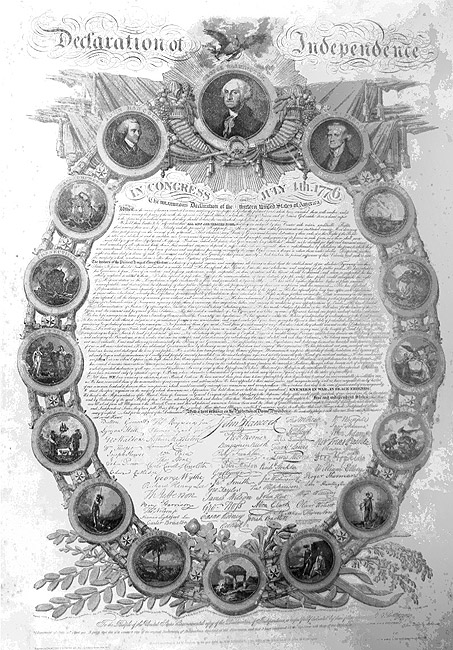 The Moss 1872 Declaration of Independence The Moss 1872 Declaration of Independence
John C. Moss, printer and photographer, produced this Declaration of Independence in May 1872 in New York City. Moss was the inventor of the world’s first practicable photo-engraving process. His legacy can be seen today in works that combine photographs with text, from postcards to coffee table books.
This is the world’s first photo-engraved document of major importance.
Moss established the document’s revolutionary importance by photo-engraving a facsimile of the John Binns Ornamental Declaration of Independence, which was produced in 1819, and is known by collectors as one of the two or three most sought after copies of the Declaration. By photo-engraving the Binns Declaration, Moss proved that he had invented a new printing process of high commercial value.
The document’s authenticity is established by the United States Copyright Office of the Library of Congress, which granted a copyright for the document to Michael George Duignan, a writer who was Moss’ financial backer, on April 8, 1872. This is the only copyrighted copy of America’s most sacred and historic document ever to be assigned to an individual!
The copyright, which remains on file at the Library of Congress, establishes not only the provenance of the document but also sets the approximate time, narrowed to within a month, of when it was published. The copyright was issued on April 8, 1872. Duignan then wrote a dedication on the bottom of the Binns document and signed his name. He included the notation that the document had been registered by an “Act of Congress” [the term then used for “copyright.”] in 1872. The copyright of the document has long expired, and the document belongs without encumbrance to the current owner.
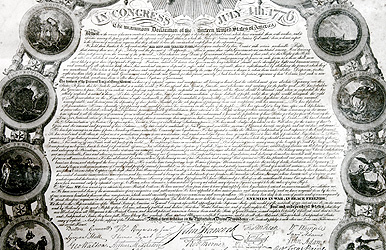 Rarity of Document – This document is extremely rare, possibly the only one remaining in commercial existence. John Moss produced it under the name of his company—the Actinic Engraving Company—which is listed at the bottom of the document. The Actinic Engraving Company was established in 1871 in New York City and was dissolved by Moss eighteen months later in June 1872 because of a lack of funds. Thus the document was produced during the two-month period after the copyright was granted on April 8, 1872 and before the Actinic Engraving Company went out of business in early June 1872. Duignan’s ownership of the copyright precluded the publication of any further copies during the coming decades, until the document had faded into obscurity. Rarity of Document – This document is extremely rare, possibly the only one remaining in commercial existence. John Moss produced it under the name of his company—the Actinic Engraving Company—which is listed at the bottom of the document. The Actinic Engraving Company was established in 1871 in New York City and was dissolved by Moss eighteen months later in June 1872 because of a lack of funds. Thus the document was produced during the two-month period after the copyright was granted on April 8, 1872 and before the Actinic Engraving Company went out of business in early June 1872. Duignan’s ownership of the copyright precluded the publication of any further copies during the coming decades, until the document had faded into obscurity.
Present Ownership – The director of a Paris graphics design business bought the document in a Paris antique shop in 1988. She purchased it not with the idea of commercial speculation but because she recognized it as a superior example of 19th Century design. The owner is now putting it on the market after her retirement with the goal of raising money for her charitable projects.
Description
Width – 24.3 inches (61.6 cm)
Length – 34.5 inches (88 cm)
Frame - The gold-gilded frame does not appear to be the original frame and is adjudged to be 80-100 years old.
Anomaly – 1.3 inch line tear approximately top middle of document. A 2.5 inch line tear on right side of document approximately nine inches from the bottom. Neither tear touches the body of the document and both are practicably unnoticeable. Neither tear has been repaired by a professional restorer. The document has a number of brown spots that are visible to the camera.
Authenticating Information
The 1872 Moss document is a photo-engraved copy of the 1819 Binns Declaration of Independence. It includes all the original identifying material that appeared on the Binns document, plus identifying material provided by John Moss and Michael Duignan.
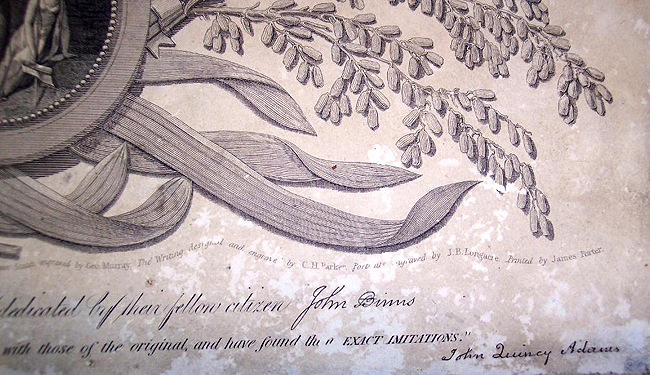
This is detail from the original John Binns DOI showing that Binns signed his name after the dedication. The dedication reads in full: "To the People of the United States this ornamented copy of the Declaration of Independence is respectfully dedicated by their fellow citizen John Binns."
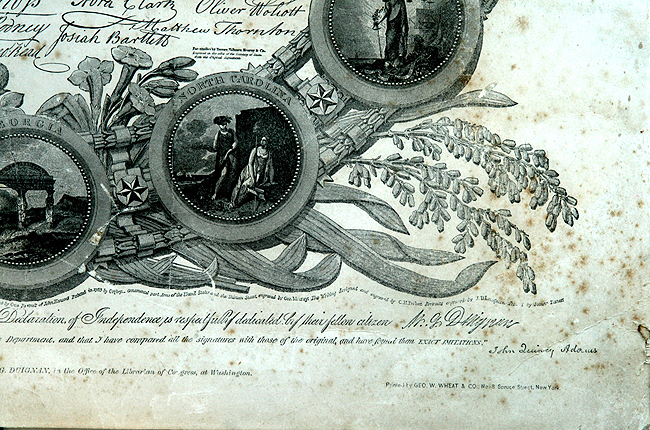
This is detail from the Moss DOI showing that Michael Duignan deleted John Binns' name from the dedication and signed his own name. Then he applied for and was granted a copyright for the document.
In a wavy line of small print running from left to right directly under the leaves and the ornamental design is the following information as it appears on the 1819 Binns Declaration:
Originally designed by John Binns Ornamental part drawn by Geo. Bridport. Arms of the United States and the Thirteen States drawn from Official Documents by Thos Sully: Portraits of Gen Washington Painted in 1793 by Stuart Portrait of Thomas Jefferson Painted in 1816 by Otis Portrait of John Hancock Painted in 1765 by Copley…Ornamental part, Arms of the United States and the Thirteen States engraved by Geo. Murray: The Writing designed and engraved by C.H. Parker. Portraits engraved by J.B. Longacre. Printed by James Porter.
Below that in large script is the following:
To the People of the United States this ornamented copy of the Declaration of Independence is respectfully dedicated by their fellow citizen M.G. Duignan
Under the Duignan Dedication is the following as it appeared on the original Binns Declaration:
“Department of State 19th April 1819. I certify that this is the CORRECT copy of the original Declaration of Independence deposited at this Department, and that I have compared all the signatures with those of the original, and have found them EXACT IMITATIONS.” (signed) John Quincy Adams
Under that is the following original material on the Moss Declaration:
Engraved by Actinic Engraving Co, 113 Liberty Street, New York. [space] Entered according to Act of Congress, in the year 1872, by M.G. DUIGNAN, in the office of the Librarian of Congress, at Washington. [space] Printed by GEO. WHEAT & CO. 8 Spruce Street, New York.
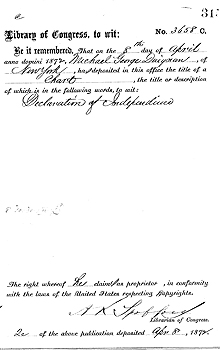 Michael Duignan’s Copyright of the Moss Declaration Michael Duignan’s Copyright of the Moss Declaration
Michael George Duignan’s copyright of the Declaration of Independence, dated April 8, 1872. A photocopy of the copyright is available on request to any researcher at the U.S. Copyright Office in the Madison Building of the Library of Congress, Washington, D.C.
Obituary of John C. Moss – Publishers' Weekly – April 1892
John Calvin Moss, inventor of the first practicable photo-engraving process and head of the Moss Engraving Company, died on the 8th inst.,[April 8, 1892] at his home, 54th Street and 4th Avenue, South Brooklyn, N.Y. He was born in 1836 in Washington County, Pa. and was early intended by his parents for the ministry. But he felt no inclination in that direction, and at the age of 17 entered a printing office in Philadelphia, devoting much of his time to the study of fine arts. When barely 19 he married Miss Mary A. Bryant, who worked with him in his experiments, and to whose aid he attributed much of his success. In 1858 he became a photographer, experimenting in photographic chemistry and studying the processes of Daguerre and his predecessors. Following the attempt of Prof. Grove to etch on a Daguerrean plate by means of electricity, he made a galvanic battery and entered into experiments which resulted in the discovery of his photo-engraving process. Realizing the value of this invention, in 1863 Mr. Moss and his wife came to New York , and for eight years had a hard struggle, getting a few orders, but meeting active opposition from the wood engravers who feared the new process would destroy their trade. In 1871 Moss organized the Actinic Company, which was dissolved the following year. With the aid of a friend he established the Photo-Engraving Company in 1873. This was successful, and in 1880 Mr. Moss left this company and organized the present Moss Engraving Company. His wife is still living, and he leaves one son.
Owner of 1872 Moss Declaration of Independence
Pythia Press S.A. - Claude Boutillon, CEO
Contact:
Janice Terry
Pythia Press
P.O. Box 2010
Reston, VA 20195
e-mail pythiapress@comcast.net
Google: John C. Moss or click on: http://en.wikipedia.org/wiki/John_C._Moss

|